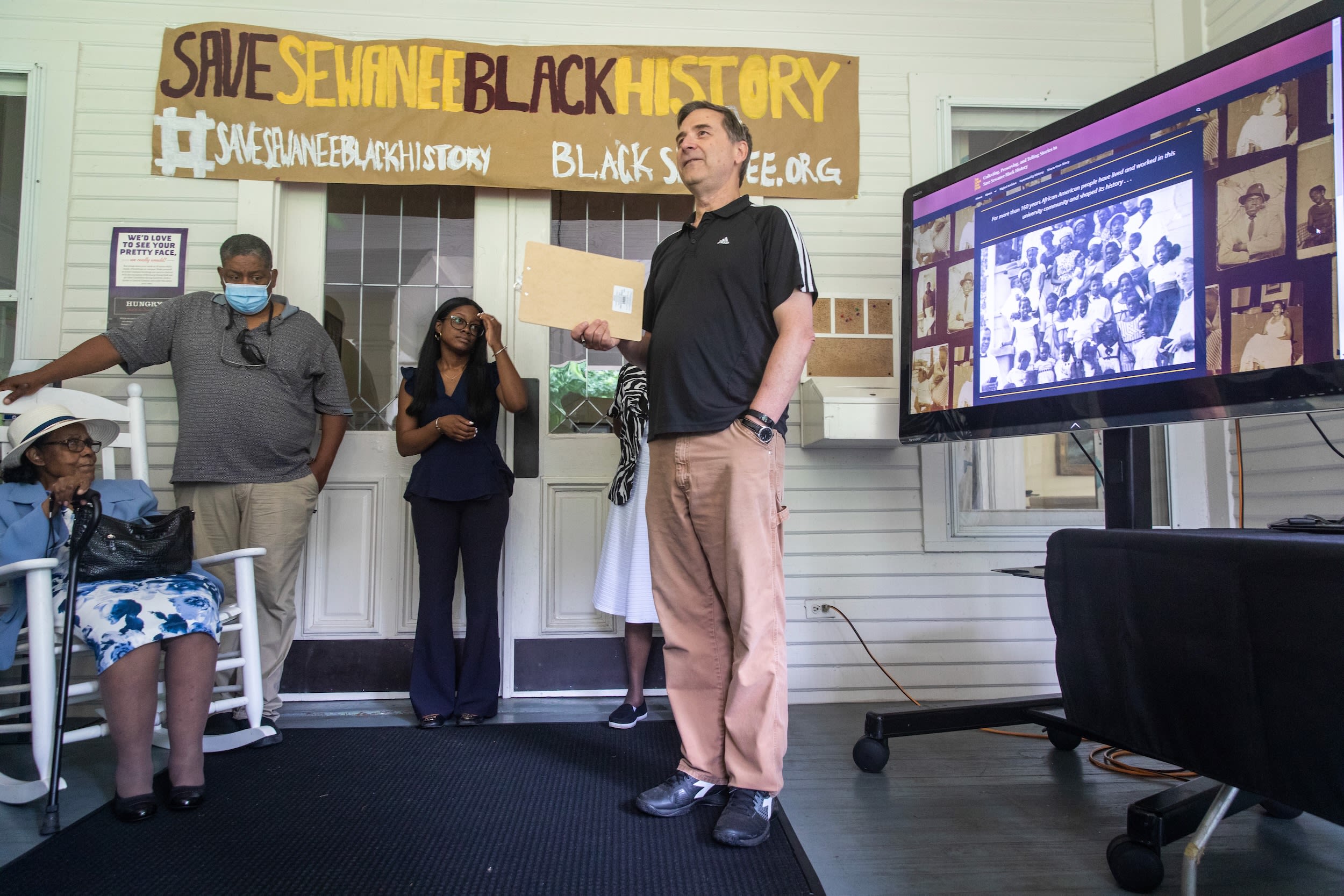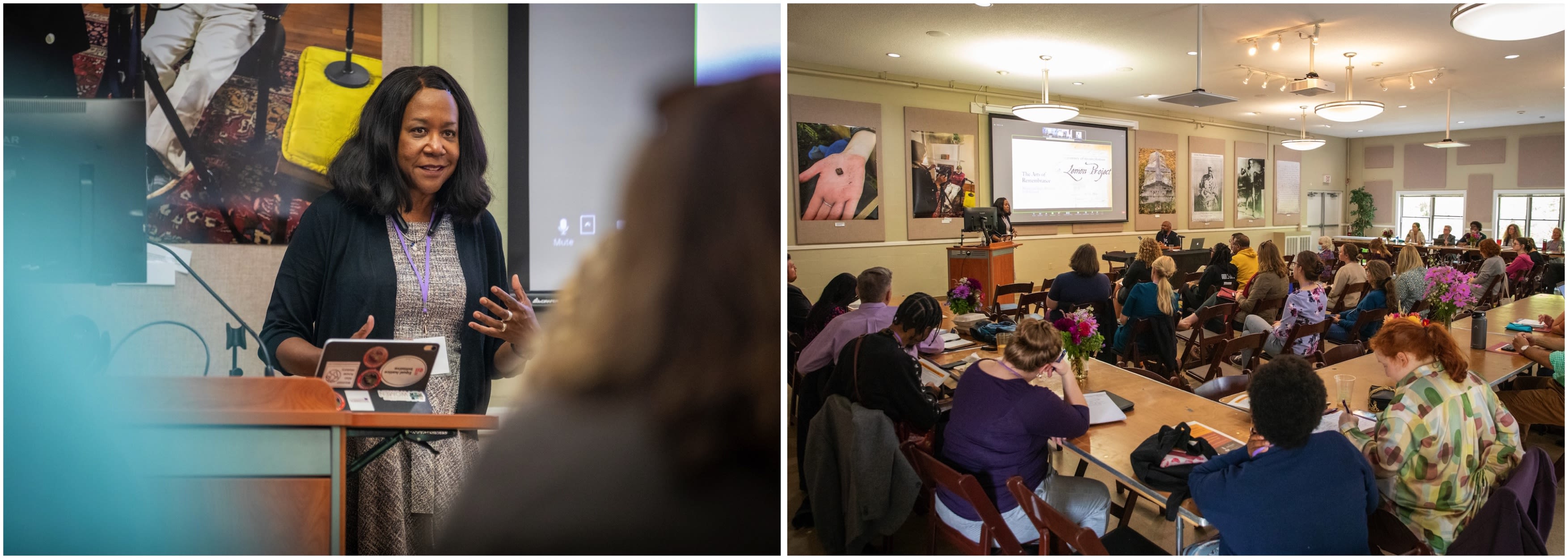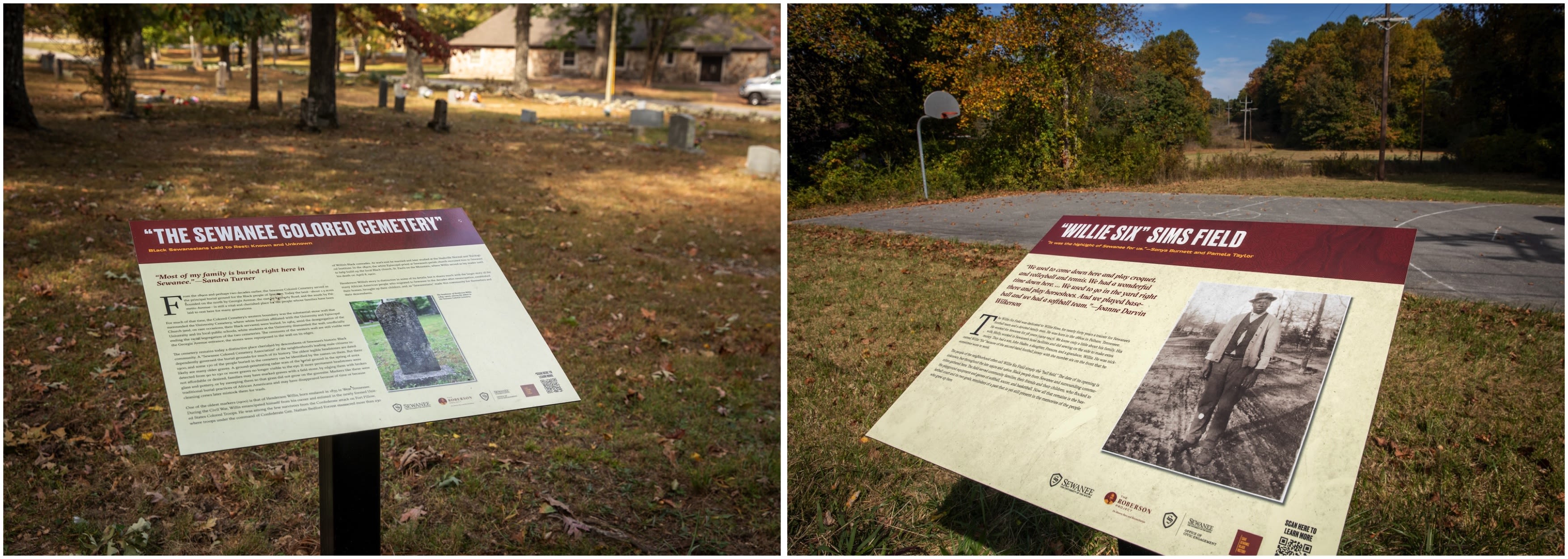The Roberson Project at Five
Half a decade into its work, the University’s project on slavery, race, and reconciliation has become a thriving humanities laboratory and has helped make Sewanee a national leader in exploring the influence of slavery’s legacies on higher education.

Woody Register, C’80, looks out over the audience at this October’s Locating Slavery’s Legacies symposium in Sewanee and shrugs, “We seem to be breeding digital humanities projects.” Register is director of the Roberson Project on Slavery, Race, and Reconciliation, a project that was authorized by former Vice-Chancellor John McCardell five years ago. Recently, Acting Vice-Chancellor Nancy Berner authorized another five years for the project.
The project represents a relatively new phenomenon in higher education; it is a robust humanities laboratory. The humanities laboratory is an approach to advancing knowledge about a topic that often uses new digital tools and methods and encourages collaboration across disciplines. In a humanities laboratory, lots of people are engaged in exploring a topic and being completely open to where that topic may lead them.
The Roberson Project, which is studying the legacies of slavery on the Sewanee campus, is a perfect example of a humanities laboratory, and, through it, Sewanee is a national leader in exploring slavery’s legacies, particularly the influence of slavery’s legacies on higher education.
The Locating Slavery’s Legacies Symposium was, in fact, important evidence of Sewanee’s leadership. Two years ago, Sewanee was selected through a national competition to be a regional collaboration partner for the Council of Independent Colleges’ (CIC) Legacies of Slavery Project. Becoming a regional collaboration partner meant that the Sewanee team (led by Register and Assistant Professor of History Tiffany Momon) could dream big about what they might accomplish in partnership with other faculty and staff at Sewanee and with faculty and staff at other select colleges in the South. “The Roberson Project is a prime example of how smaller independent colleges contribute to local, regional, and national conversations about the long shadow of slavery,” says CIC Director of Projects Philip Katz. "The various initiatives undertaken by the project and its spirit of honest reckoning are models for other institutions that grapple with issues of race, justice, and memory."
The symposium was both a deliverable for Sewanee as a collaborative partner and an opportunity to highlight the multifaceted work that has been accomplished by students and faculty across the University.

Jody Allen, director of the Lemon Project at William & Mary, addressed the Roberson Project's Locating Slavery's Legacies symposium in October.
Jody Allen, director of the Lemon Project at William & Mary, addressed the Roberson Project's Locating Slavery's Legacies symposium in October.
The project’s website captures some of that multifaceted work, highlighting projects that have been financially supported by CIC, the Bonner Foundation, the Mellon Foundation (with these grants providing further evidence of national leadership), and quite a few alumni donors:
- Locating Slavery’s Legacies—an interactive database that Sewanee is developing with CIC funding to catalog physical legacies of slavery on its own campus. Other collaboration partners will also be able to use the database, and the project will launch with at least six collaborating institutions in spring 2023.
- Save Sewanee Black History—a project that was initially launched through a grant from the National Endowment for the Humanities to develop a community archive.
- St. Mark’s Heritage Trail—a project funded by the Bonner Foundation that provided funds to students to construct a heritage trail in Sewanee’s historically Black community. Generous gifts from alumni have enabled the students to augment the designs for the trail.
In the first years of the project, Register and the Roberson Project’s first research associate, Tanner Potts, C’15, built the Sewanee Place Name Journal and explored the connections between founders who enslaved people and the governance of the University.
The full body of the project’s work is much greater than what is published on the website, however. Register reckons at least 20 students—from both the College and the School of Theology—have completed research related to the project, but then he remembers two or three other categories of students who are working on exploring the legacies of slavery under the auspices of other faculty or programs.
“There really are multiple avenues for students to get deeply involved in the Roberson Project,” says Register, who notes that Sewanee’s most recent Rhodes Scholar, Klarke Stricklen, C’22, was a four-year research associate with the project. “The Roberson Project took us to places we should have gone, but we didn’t have premeditated plans to go there. That’s a quintessentially Sewanee phenomenon of drawing on the imagination of students and faculty to explore questions that interest them. It’s like we had a package of seeds and didn’t know what they were, but we scattered them on the ground and all this amazing work sprouted.”
One of the most fruitful strands of work has been an archive for Sewanee’s Black community that was initially launched through a grant from the National Endowment for the Humanities and then took on new energy as Sewanee hired Momon, a highly accomplished public historian. The founder of the Black Craftspeople Digital Archive, Momon elevated Sewanee’s digital humanities capabilities. She worked for a consulting firm before starting her second career as a historian of the decorative arts. “I’ve been telling stories digitally for many years,” Momon tells the symposium audience. “It was a natural thing for me to use digital tools for scholarship.” One of the benefits of digital humanities and public humanities is that they democratize both the production and dissemination of knowledge. Historians generally write for professional peer-reviewed journals, leaving the work of dissemination to journalists and others who can translate the findings. Digital humanities allows more people to be involved from the very beginning.

Interpretive signs on the St. Mark's Heritage Trail highlight sites of historical significance to Sewanee's Black community.
Interpretive signs on the St. Mark's Heritage Trail highlight sites of historical significance to Sewanee's Black community.
That democratic production and dissemination of knowledge was highlighted in one of the symposium’s sessions, with Momon pairing up with local community members LaNetra McLemore and Karen Morris, who for the past two decades have been collecting information about the Asia School in northwest Franklin County, and the community that surrounds it. The presentation covered the joys and challenges of community archiving. “When you involve a community in an archiving project, it’s really important that they have ownership of the project, that their work belongs to them,” says Momon. The Asia School project is now part of an umbrella archive called Black South Cumberland, which will begin building archives for the Sewanee Black community as well as the Townsend School community in Winchester.
“We’re like car mechanics,” Register says of the project. “Ms. McLemore, for example, has two decades of work in that community, and much of it is in her head. We are able to use digital tools to make that intellectual capital accessible to others. We are getting the car running, but the people in the community are driving it.”
While the Roberson Project has garnered national acclaim and launched a movement at Sewanee and a community of scholars in a far-flung network, the work has faced some opposition. At the symposium, Sharon Leon, director of the Omeka suite of web-publishing platforms (software often used to publish digital humanities projects) asks Momon and Register, “Are there days when you get pushback on your work?
“Many days,” admits Momon. “What you have to remember, though—and this is what I tell my students—all our work is based on primary sources. Nothing is made up. If you have an argument with what we are presenting, that argument is not with me; it’s with that person in the past who recorded the evidence or recounted what happened. It’s an argument with the dead.”
The Roberson Project decidedly does not have an argument with the dead. Instead, the overarching goal of the past five years—and the next five—is to uncover parts of the Sewanee story that have not been told, the parts left out because the people involved did not have the social capital to have their stories told.
“We really want to have a fuller and richer account of the Sewanee story,” says Register. “Our purpose is to intervene in our memories, give opportunities for memories that are reparative in some way, that complicate and make our story more inclusive. Because the Sewanee story we want to tell is more inclusive; we hope that it’s more truthful.”
One example of a story told from another perspective is a film by Zaire Love, a Memphis filmmaker, featuring Sewanee students and people who grew up in Sewanee's Black community, called “Making Our Way.” The film premiered in Sewanee on Sept. 19 and is part of a busy fall and the beginning months of five new years. Love made several trips to the Mountain and settled on a film that features intimate interviews with Black students talking about how they have made Sewanee their own place.
With five years behind it, the Roberson Project has built up a head of steam. Its reach has become multi-institutional. It has been able to hire expert staff for its growing digital projects. It is a model for how to build a digital humanities laboratory on the Sewanee campus, potentially creating new areas where faculty, staff, and students can collaborate. And it is reframing the Sewanee narrative.
